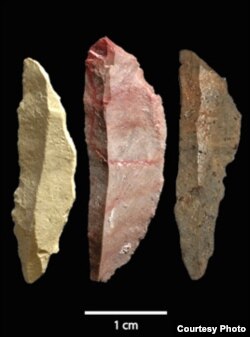Archaeologists digging at a site on the southern coast of South Africa have found a trove of sophisticated stone tools they believe were made 50,000 years before the technology to create them emerged in Europe and other regions of Africa.
The finding, reported in the journal Nature, could mean that the first modern humans evolved where the Indian Ocean meets the Atlantic.
Small blades, called microliths, were unearthed at Pinnacle Point, about 500 kilometers west of Cape Town, and dated back 71,000 years.
The thin, 3-centimeter-long blades were carefully crafted so they could be glued into slots at the tip of arrows or spears. Such projectile weapons gave these early humans a significant advantage when facing a prey animal - or a competing human.
According to Arizona State University professor Curtis Marean, director of the Pinnacle Point excavation, the lethal technology “probably laid the foundation for the expansion out of Africa of modern humans and the extinction [of] our sister species, such as Neanderthals,” who did not have such projectile weapons.
Previous digs have found similar stone weapons in use during an ice age 60,000 to 65,000 years ago. But the technology appeared in what archaeologists call a "flickering" pattern, with struggling cultures acquiring the weapons-making skills but failing to pass them on, and the technology seeming to vanish.
The new find means the method actually was passed on through generations and survived for more than 10,000 years. Professor Marean believes field work in Africa will continue to push back in time the evidence for uniquely human behaviors.
A University of Toronto-led team of anthropologists working at another site in South Africa has done just that, finding new evidence that early human hunters were attaching stone points to the tips of their spears half a million years ago - 200,000 years earlier than previously thought.
The researchers examined 500,000-year-old stone points from an excavation at Kathu Pan 1, in Northern Cape province, and determined that they had been used as spear tips. To do that, they recreated the ancient weapons and used a calibrated cross bow to shoot the replicas into an animal carcass.
Then, they compared the wear and damage on each set of stones. The prehistoric points showed the types of breaks that occur more commonly on spear tips than on stones used for other purposes, such as scraping and cutting.
The points were tied onto wooden spears, a process called hafting, which was an important advance in hunting weapons. Hafted spear tips are commonly found in 300,000-year-old Stone Age sites. The new study shows the technique was used in the early Middle Pleistocene, a period before Neanderthals and modern humans embarked on separate evolutionary paths.
The study is published in the journal Science.










